Close encounters of the plant kind at Great Dixter garden, part 1
After spending the morning at Sissinghurst, during our travels in mid-June, we drove a half-hour to Great Dixter, another famous English home and garden at the top of my must-see list.
The family home of gardener and garden writer Christopher Lloyd, who died in 2006, Great Dixter continues on under the stewardship of head gardener Fergus Garrett. The gardens encircle the old manor house (the timbered part at the front door dates to the 15th century and has a pronounced and quirky lean), which is open to the public, and extend to a couple of barns and an oast house. We toured the house, but the gardens were what I came to see, so let’s take a tour.
Like Sissinghurst, the gardens at Great Dixter are defined by hedges that divide the rural property into distinct rooms. We entered the Peacock Garden first, where numerous tall, clipped pyramids culminate cheekily in what looks more like a bushy-tailed squirrel than a peacock.
I’m a fan of topiary amid a wilder garden, as well as goofy touches like squirrel-peacocks, so I was eager to explore.
A few other visitors were strolling the paths, but nothing like the crush of people at Sissinghurst, for which I was grateful.
We accidentally detoured out of the Peacock Garden and found ourselves at a small pond smothered in waterlilies.
A massive compost pile also caught my eye. That pile of straw is head-high, with flowering perennials that seemed to be growing from it. Were they recently tossed there, or did they spring up from seed?
A square lattice gate and stone path led us back into the garden…
…where the flora soared skyward.
Clipped shrubs and hedge walls loomed over extremely narrow paths, with tall flowering plants pressing in from the center of the garden.
You walk the paths as if through a wild, overgrown meadow, or even a jungle, skedaddling sideways and pushing plants aside as you make your way through.
I have to confess something: I didn’t like it. I didn’t get it. It felt claustrophobic. I felt as if I couldn’t see the garden for all the plants. My family and I joked that we needed a machete to get through it.
Don’t get me wrong. There was much beauty, including lovely flowers…
…sparkling plant combos…
…and surprises like this flowering yucca (looks like Yucca recurvifolia), which reminded me of my Texas home.
But my overall impression was a sense of being overwhelmed.
And a sense of puzzlement that I wasn’t enjoying it more, when so many others have swooned over it.
Close-up details were pleasing, like these purple poppies and daisies…
…and a ribbon of red poppies weaving through a meadowy space enclosed by architectural hedging.
Here’s looking at you, kid.
But I struggled to make sense of the garden as a whole, with only occasional long views opening up on the bigger picture.
Half amused, half worried, I began to wonder if I was simply a philistine. Why was I not getting it?
To be honest, I’m still wondering. Looking back at my photos, I see plenty of beauty and interest.
When they weren’t towering over my head and pressing insistently upon me, obscuring the actual view of the garden, I more easily appreciated the beauty of individual plants…
…and their companions.
But I never felt moved by Great Dixter. When I got home, I called up a friend who apprenticed there as a gardener and asked him to explain it to me. He asked me if I didn’t like the hedge structure and meadows (I did; see Part 2 of my visit) and suggested it was more of a plant person’s garden.
It’s true I’m not a plant person but rather a design person, and I’m all about the mood a garden creates.
Like all art forms, a garden either touches your heart or it doesn’t. Maybe you can’t really explain why, although I think it’s useful to try.
And maybe this one would touch mine on a different day or season, or in a different mood.
This more traditional border, full of golden foliage and flowers and, crucially, with space to breathe, did appeal to me. I especially like the way the gold stands out against the emerald hedge.
I’ll keep thinking about Great Dixter, especially as I’ll be writing about other sections in my next post. After all, it’s good to mentally garden too — to till the soil and examine what it is that moves us about a garden. Don’t you think?
Coming up next: Part 2 of my visit to Great Dixter, including the Long Border, Topiary Lawn, and Sunken Garden. For a look back at Part 2 of my visit to Sissinghurst, click here.
I welcome your comments; please scroll to the end of this post to leave one. If you’re reading this in a subscription email, click here to visit Digging and find the comment box at the end of each post.
_______________________
Digging Deeper: News and Upcoming Events
Join the mailing list for Garden Spark Talks! Inspired by the idea of house concerts, I’m hosting a series of garden talks by inspiring designers and authors out of my home. Talks are limited-attendance events and generally sell out within just a few days, so join the Garden Spark email list for early notifications. Simply click this link and ask to be added.
All material © 2006-2018 by Pam Penick for Digging. Unauthorized reproduction prohibited.


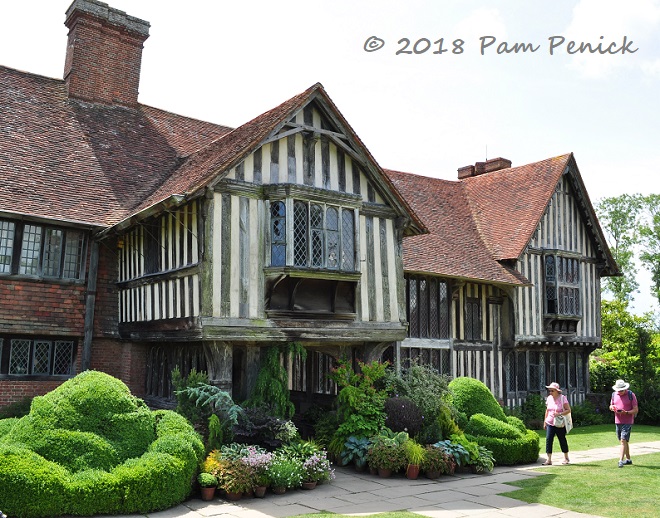











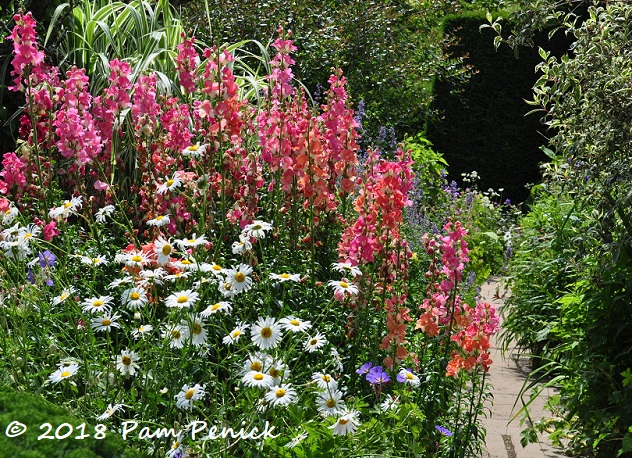
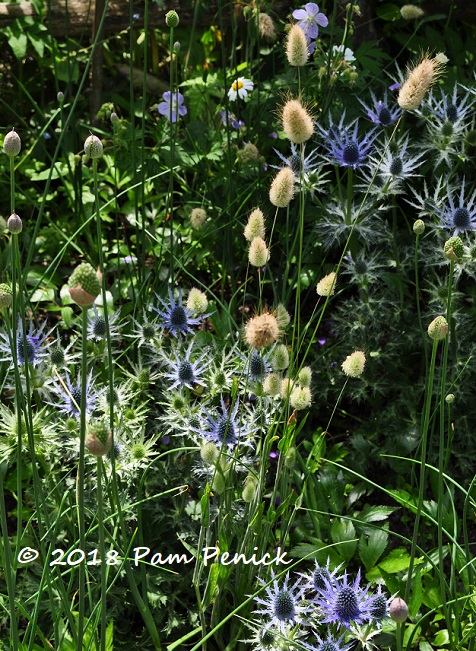

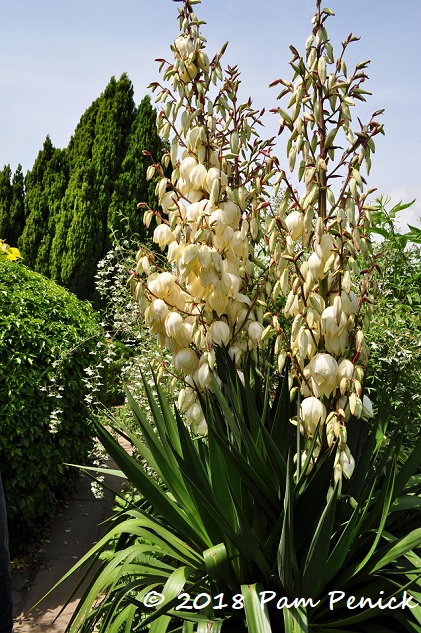

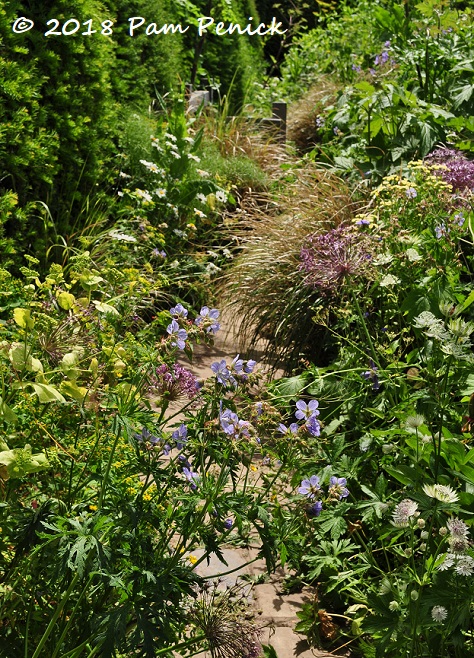









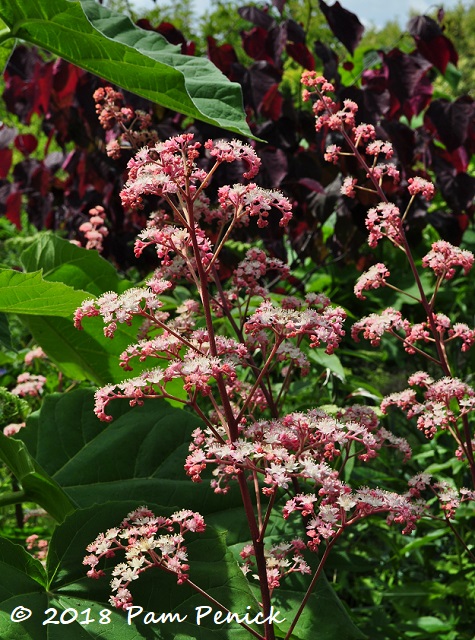

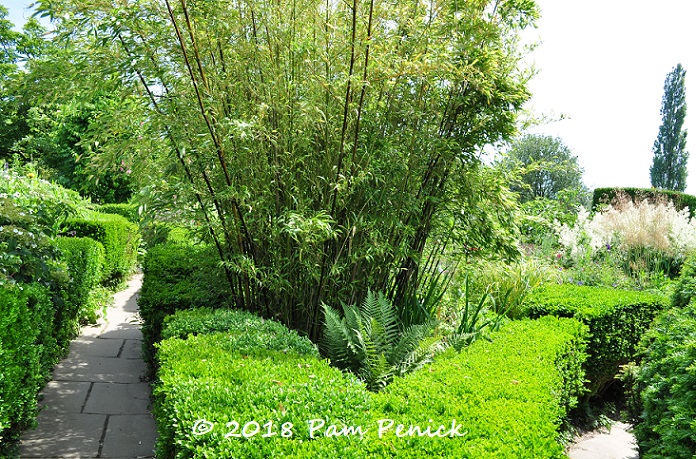
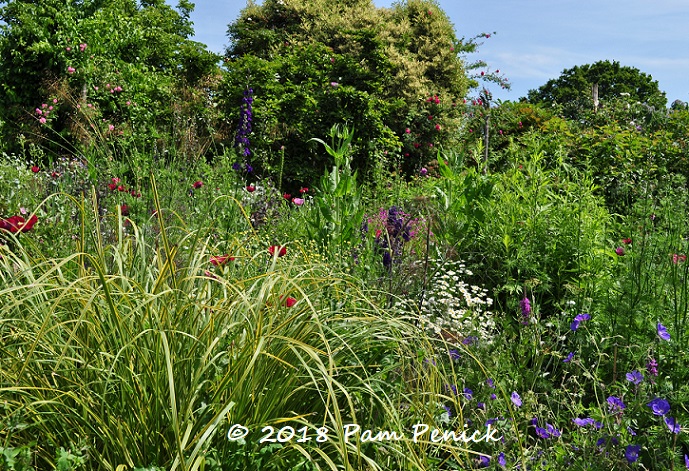

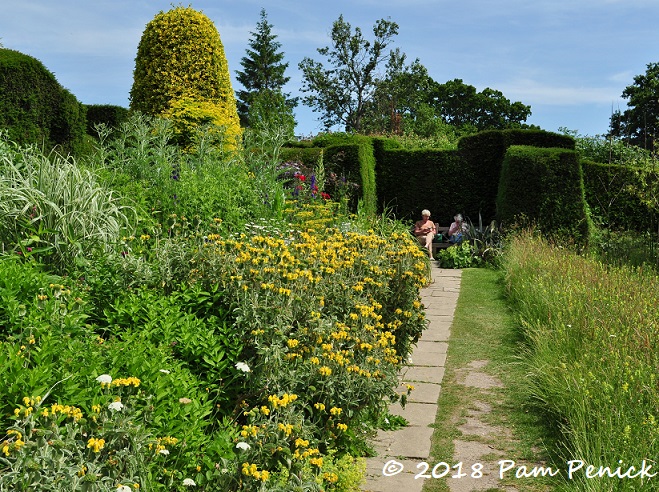

This is an interesting post to read just a few days after I had a similar reaction to Dan Hinckley’s garden at Windcliff. I visited there with Loree and Peter this weekend, and it is claustrophically full of plants, and so hard to move through, or to see the overall design of the space, and I’m a plant lover, not a designer. I love his previous garden Heronswood, which still exists and which I visit every chance I get.
This is so interesting to read Alison! When I got your text that you’d gone next door the thought crossed my mind, is she not enjoying this garden? But then by the time we met up at the end I was so lost in my own head that I forgot to ask you. I’ve visited Heronswood just once, and now Windcliff once. I am going to have to think on it but if you asked me which one I wanted to return to right now I think Windcliff would win.
Loree, thanks for sharing your perspective on Hinckley’s garden. I’m heading over to your blog to see if you’ve posted about it yet.
Ha! No post on Windcliff for awhile Pam. I’ve only been home for about 24 hours and I took over a thousand photos and visited seven gardens and a nursery during my weekend in. Washington.
Jeez, so lazy, Loree. Get on it!
I’m fascinated to hear that, Alison, as Hinckley’s garden(s) are on my bucket list too. Are you going to post about it?
Have you by chance discovered the blog The Lower Left Corner? (https://thelowerleftcorner.com/2018/07/30/great-dixter-visit-july-20th-part-1/) She’s been detailing her visit to Great Dixter and I’ve been eating it up. Her appreciation has me wanting to jump on a plane. I find your reaction so interesting! Eagerly awaiting part two…
I know her blog but haven’t read her Dixter posts yet. Thanks for the heads up! I’m going to hold off on reading hers until my own are done, and then I’ll check them out. Sounds like it’ll be an interesting contrast!
Every garden needs negative space… Actually, EVERYTHING needs negative space! A place of rest amid the chaos. But mostly, in the parts most uncomfortable in your photos, it feels like a maintenance issue to me. If the artists’ mind is not there to ruthlessly edit, things get overgrown and everyone “likes” the plants and no one wants to cut them back! It just plain looks overgrown, during your visit.
In the last two photos, where they mowed a strip along the path–that gives a little relief! Some empty space…just a little. I’m referring to the strip of lawn. It remedies the proportion problems, feels a lot better than that overcrowded paths.
I think it’s a really fine line to walk, especially in big perennial beds, don’t you? So hard to get it just right. And then when you do, it’s changed again in 6 months.
Thanks for your perspective, Alyse. I suspect that wild, overgrown feeling is purposely cultivated at Great Dixter. And that’s what people who love the garden seem to love about it. As I’ve read on other sites, people see the garden as upending traditional rules of garden design in making the plants overscaled and dominant, rather than offering negative space and a separation from the plants. It just didn’t work for me.
This isn’t the first time I’ve read a reaction of claustrophobia to parts of Great Dixter, but what struck me about your visit was that it took place in June. What must September be like in those too-narrow pathways?
The phrase “wamblecropt with flowers” has stayed with me from one such review at thinkingardens.com. For an early-season tour when the shrubs and perennials haven’t swallowed everything, I recommend plantsman Panayoti Kelaidis’ post: https://prairiebreak.blogspot.com/2017/12/great-dixter-on-friday-april-14-2017.html
Thanks for sharing the link to Panayoti’s post from an earlier season, Nell. I think I would enjoy the garden more at that time of year.
I saw Great Dixter in the spring (May 1, 2010) and I loved the plantings and was surprised at how much exposed soil I could see! So maybe, seeing it earlier would have changed your perspective! Speaking as a plant lover, I wish I had more plant designer in me so that I could be a more ruthless editor in my own garden!
It’s always a balancing act, isn’t it, Gail? And some people lean more one way than the other. This garden taught me which way I lean, if I didn’t already know. 🙂
I have felt this way in some tropical gardens. Where there is so much growth you wonder if you are even still on a path. At least in this garden I would know what was about to over take me. ha… Maybe you would enjoy it more during winter when plants are quite as exuberant.
Or spring — yes, maybe so.
I understand your feelings of claustrophobia, Pam. I haven’t experienced that at Great Dixter, but I’ve visited only earlier in the season. In June the narrow paths were exciting. I felt a bit like Alice in Wonderland, shrinking and expanding as the plants closed in or opened up.
I like Great Dixter very much; by a narrow margin I like it more than Sissinghurst. There are some wonderful quirky touches (which undoubtedly existed at Sissinghurst in Vita and Harold’s day but which the National Trust now seems to have eliminated,) The Long Border is perhaps my favourite section — the plant combinations are spectacular. I also love the sunken garden and the semi-circular steps which have used different plants each time I’ve visited.
Most of all, though, I appreciate your willingness to offer a clear and critical view of an iconic garden. Criticism can be hard, particularly when your view goes against the majority. But sometimes the Emperor’s lack of clothes has to be pointed out.
On this point, you may want to check out the latest post on Thinking Gardens. https://thinkingardens.co.uk/articles/general-interest/do-you-dare-by-anne-wareham/
Anne Wareham writes about the lack of solid criticism within the British gardening community and the risks one takes when criticizing a garden designed or made by someone well-regarded.
Our visit was in mid-June, just to clarify. I appreciate your comparison to feeling like Alice in Wonderland while exploring the narrow, plant-dwarfed paths. I can see the excitement in that. For me, it just felt jungly in a way that an Austin summer-rank garden can get. I wanted to get out the machete!
It *was* difficult to decide whether to offer my unvarnished opinion of this iconic garden. One worries about hurting people’s feelings or offending or, perhaps worse, being seen as a rube who can’t appreciate things properly. But then again, if you can’t express your true feelings on your own blog, then what (or who) are you blogging for?
Thanks for pointing me to Anne Wareham’s latest post about garden criticism. I hadn’t read that one yet, but her earlier writings have definitely inspired me to be more thoughtful and, if necessary, critical in my garden writing — about public gardens, mind you, not private gardens, visits to which are like being invited as a guest into someone’s home. Totally different rules apply then, to my mind anyway.
I think you hit on something when you talked about seeing the garden in another season. It seems that most of the plants that were blocking views, access, etc. were perennials/annuals that would be gone during the winter, spring, and early summer. Visiting Windcliff with Alison and Loree recently, I noticed that it seemed much more full than when I’d visited at other times of the year. I’m a plant person by default because I know nothing about design and try to cram as many plants as possible into my small urban garden. At this time of year, my own space bugs me a bit but I just wait it out knowing that winter will take care of a lot of issues. I like your point about gardens being like art; not all creations will appeal to all people.
I think this overblown look is intentional at Great Dixter, but yes, I personally might enjoy the garden more in an earlier season. And I think you are too modest about your design skills, Peter. You have a definite sense of design, which I always enjoy in photos of your garden. Keep cramming and having fun!
I’ve loved my two visits to Great Dixter, but your photos are definitely showing an overgrown version, compared to my visits (once in May and once in September). Those paths look forbidding!
I was captivated by the interesting plant combinations, overlapping colors and textures, and the exuberance and novelty of some of the spaces and how plants were used in them. It really blew me away on my first visit (about a decade ago).
I appreciate hearing what you loved about it, Lisa. It’s always part of the adventure of garden touring to see how we react to a garden, isn’t it?
Thank you so much for this, Pam. I haven’t visited Dixter for many many years so I can’t comment on the garden, though I have heard rumours that other people have felt the same way.
But it’s such a relief when someone dares to say something other than ‘lovely garden’ and then to say what their difficulty was.Makes me feel less mad.
I suspect being a plantsperson (A polite way of naming someone who collects plants obsessively?) enables people to enjoy what the rest of us fail to relate to. Two plants looking exciting together just make me want to plant loads of them and really create a wow, not stuff different ones around them.
I consider space in a garden as important as the plantings (it’s one of the things lawns offer) and the play between the two should be a delight.
A brave piece. A treasure for some of us. Thank you. xxx
Thanks for your comment, Anne. Your honest thoughtfulness in writing about gardens has given me much to ponder over the years.
To clarify, in the sense that I used it, a plant person is someone who values the qualities or rarity of individual plants over larger design considerations. Collectors fall into this category for sure. I don’t find anything wrong with that way of experiencing or appreciating a garden. It’s just not what interests me.
I do find it interesting that the design at Great Dixter upends conventional “rules” about planting and viewing. But such rules are generally agreed on for a reason, and I missed seeing the forest for the trees.
I get what you’re saying, Pam. We were there at the same time of year about two years ago. I was surprised at my reaction as well. There were spots I really loved and others not so much. I came to a much greater appreciation for it when I came home and had a chance to read the small booklet I bought there – then I wanted to go back and see it anew.
It certainly can help one appreciate a garden to learn more about the intentions behind it. I should have bought that little booklet as well!
Your post and the comments of readers are interesting, Pam. I consider myself a plant person first (even if I try to also consider the overall composition) but, based on your photos, I think I’d have found many areas within Great Dixter claustrophobic as well. Is the current garden faithful to Christopher Lloyd’s vision, or might it be overgrowing its original boundaries? I’m going to pull my copy of Lloyd’s ‘Flower Garden’ to see if that gives me a different perspective.
That’s a good question, Kris. I don’t know enough about the garden to say. My only perspective is how I felt during my visit. As we gardeners know, of course, that’s only a snapshot of a moment in time. I’d love to have the chance to see it again one day.
How interesting! I loved what I saw in this garden on a rainy May day in 2016 ( http://tanyasgarden.blogspot.com/2016/05/great-dixter-garden-from-under-my.html). Just loved it.
Now, I see how it looks on a sunny day in June. …Very different!
Thank you Pam!
Thanks for sharing your lovely post, Tatyana!
I’ve photographed Great Dixter for many years and consider it one of my favourite gardens. Christo was definitely a plantsman with an amazing ability to combine plants in original, exciting and unexpected ways. Yes, Great Dixter is overwhelming but that was part of his vision. A vision that to me, makes the gardens feel like a setting from Lewis Carroll’s Wonderland. So maybe you felt at times a bit like Alice, lost in a strange and unfamiliar world. It is not everyone’s ‘cup of tea’. Maybe you need to be a bit ‘mad’ to enjoy it fully but I for one love it.
Thanks for sharing your perspective, John. It is definitely an immersive garden, and I can see why that feels exciting. My reaction is clearly the odd one out. I’d love to visit again one day and see if I feel the same way or if it was just a day in which the connection didn’t click.
I personally love Great Dixter and I know its parts and paths like old friends, first from reading Christopher Lloyd long ago, and from several visits. But I do have designer friends who say “It’s not my thing.” So I think there is room for all kinds of opinions, and I’m glad you were willing to say what you thought. Anne Wareham is right. Too often critics and writers are damned for expressing their true views.
Thanks, James. I’m glad you agree it doesn’t take anything away from a garden to have a dissenting opinion from the majority. I still found much to enjoy here, and I really appreciate hearing what others love about it, especially those who have visited multiple times. That’s what allows you to really understand a garden anyway.
Interesting discussion, Pam. Having visited Austin gardens, I can see how negative space and clear design intentions might be baked into your psyche! Dustin told me you discussed your visit with him. I’ve discovered so many good plants through Great Dixter — so the obsessive plants people nourish the design-focused people, and hopefully vice-versa!
I wondered myself if my Western-influenced eye — with an appreciation for more openness — made the jumble of Great Dixter less beloved for me than for others. But I suspect it’s just a personal preference.
Well done for saying how you really felt and not feeling pressurised to say it’s lovely.
I spent a day at the garden a few years ago having been an avid fan of Lloyd for years. I did a workshop which was good and then explored the garden. I too felt confused at my reaction. I didn’t like the long border which features in all the boxes, it left me underwhelmed. I liked the area where you felt overhwhelemd which that year was full of poppies and the effect was very painterly but I didn’t enjoy the pushing through the plants that much, despite loving plants.
I didn’t like the layout of the garden as I felt disoriented and I think that is because it’s so overgrown.
I wonder if we build up our expectations from all the publicity and they are experts at self promotion and in our heads it becomes something else. If we think about our own gardens we are all selective about what we show so I was surprised when I visited your garden at the levels which I hadn’t previously picked up on. Great Dixter nearly always focus on the long border and not the rest iof the garden.
The other thing isn’t that it prides itself on being a high maintenance garden, giving amazing training but I’m not so sure if that is the sort of garden I like these days.
I loved the house more than the garden which was strange and I came away feeling that I had missed the point somehow.
Thanks for your thoughts and sharing your experience, Helen. To be sure, there WAS much about the garden I found lovely. But the overall design of the hedged gardens, which I entered first, left me feeling — exactly as you say — that I’d missed the point somehow. I wasn’t disappointed so much as puzzled.
As for what one shows in photos, myself included, well, that’s easy — it’s what photographs well. Certain areas of my garden do not photograph well or easily. I find conveying the slopes particularly difficult. And I suspect that what is well designed photographs the best, so it points out where there’s more work to do, eh?
I see and agree–claustrophobia inducing in spite of all the gorgeous.
One thought: a person fortunate enough to live there, who sees the garden in all seasons, would experience a bare, austere space in winter and delight in contrasting winter austerity with the infant emerging life of spring, the claustrophobic overload of summer, and the fading melancholy of autumn. In the context of four seasons, would it make more sense?
Absolutely, HB. I can see it working so much more powerfully in that context. This is one more reason why a single garden visit never tells the whole story. Thanks for sharing your thoughts.